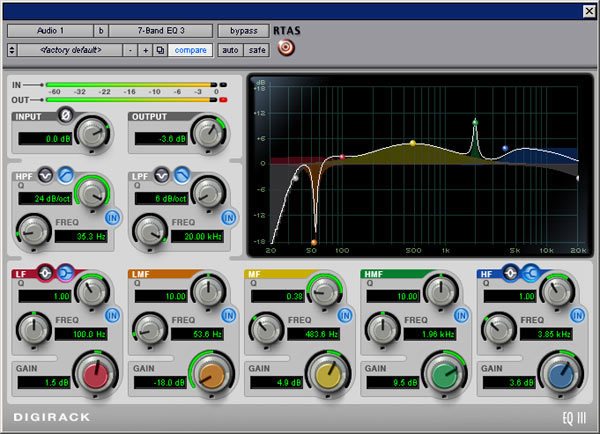Advanced effects: Essential EQ tips
Get your mixes sounding clear and concise

Despite being one of the most universally used effects, EQ can take a lifetime to master. That said, here are some essential EQ tips that should speed things up a bit. While we're on the subject, make sure you also check out our in-depth look at EQ.
1. If you find yourself applying excessive EQ on a regular basis, there are two possibilities - you're picking the wrong sounds to begin with or you're the next big thing. If you think it's the latter, wait a year, and if you haven't had three acclaimed singles and a hit album then refer to the first point.
2. Any frequencies below 30Hz are usually inaudible sonic pollutant, soaking up precious headroom and generally muddying up your mix. It's therefore always a good idea to cut everything below around 30Hz - this way your mix will be louder and your bass will sound much punchier and heavier.
3. The key to good parametric EQing is finding the right frequency, and the easiest way to do that is to apply excessive gain and set your Q to a reasonably narrow frequency. Now, when you sweep the frequency range, you'll be able to hear when you hit the target frequency.
4. Air soaks up high frequencies more than low frequencies, and low frequencies travel slightly faster than high ones, so distant sounds seem inherently less bright. You can use this effect and EQ your mixes to give certain elements a greater sense of distance by applying high-shelving cut.
5. EQ boost and cut both affect the volume of a signal, and obviously the greater the cut or boost, the more the volume is affected; so whenever you apply EQ be prepared to tweak your level settings too.
6. If you're using mastering EQ (either graphic or parametric) on a complete mix, then you should almost always place it before any limiting you're applying, as otherwise you'll risk losing some volume or pushing the signal into clipping.
Get the MusicRadar Newsletter
Want all the hottest music and gear news, reviews, deals, features and more, direct to your inbox? Sign up here.
7. Analyse all of your main sounds (such as vocals and guitars) together and in isolation and see if they're fighting for the same space in the mix. For example, vocals tend to be centred around 1-3kHz, so try a little cut in that range on your guitars and hear the two separate beautifully.
8. One of the best ways to get parts - such as backing vocals or layered guitar lines - to gel together is to run them off to their own bus and apply any EQ tweaks to the bus, rather than the original parts.
9. Most sounds are centred on a certain part of the frequency spectrum but also have stuff going on in other sections - everything else is a potential source of sonic pollution. Judicious use of high and low shelving or cut can help give everything the space it needs.
10. Generally speaking, human hearing is less attuned to EQ cut than it is to EQ boost, so if you want to achieve a more natural sound from your processing, try to avoid any excessive EQ boost. Instead, make sure you opt for cuts in competing frequencies.
11. Ear fatigue is much more of a problem with high frequencies, so always apply treble boost in small steps, and when A/B-ing the sound with and without treble, give yourself at least a minute to readjust to the dry version and allow objective assessment.
12. Spend some time learning the different frequency ranges for common instruments. Use your parametric EQ with plenty of boost and a medium Q setting and sweep the frequency range up and down while you listen to some tracks. Make notes about which frequency range each instrument is centred on.
Keeping it flat
While we might all scrimp and save to buy speakers and amps boasting perfectly flat frequency responses, without any bias to top, middle or bottom, the truth is that our hearing response is anything but flat. And the plot thickens as we reduce or raise the volume of what we're listening to. For example, at low levels our hearing is more attuned to middle frequencies, but as we raise volume, the mid-range response falls off, while the upper and lower frequencies become more noticeable, resulting in the 'smile' curve on a frequency response graph of our hearing. We can use this fact to make our mixes sound apparently louder, simply by emulating this type of curve in our mixdowns, and two of the best tools for this job are the graphic EQ and spectrum analyser. Of course, the extent to which you do this depends largely on the type of music you're making. Electronic styles can obviously benefit more from the 'smile' technique than classical recordings can.
MusicRadar is the number one website for music-makers of all kinds, be they guitarists, drummers, keyboard players, DJs or producers...
- GEAR: We help musicians find the best gear with top-ranking gear round-ups and high-quality, authoritative reviews by a wide team of highly experienced experts.
- TIPS: We also provide tuition, from bite-sized tips to advanced work-outs and guidance from recognised musicians and stars.
- STARS: We talk to musicians and stars about their creative processes, and the nuts and bolts of their gear and technique. We give fans an insight into the craft of music-making that no other music website can.










